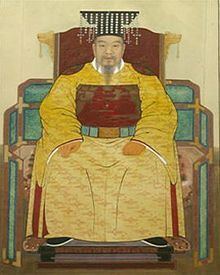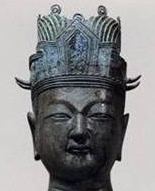Coronation July 25, 918 | ||
 | ||
Reign July 25, 918 – July 4, 943 Born January 31, 877 ( 877-01-31 ) Spouse Queen Janghwa, Queen Sin-ui Children Gwangjong of Goryeo, Hyejong of Goryeo, Jeongjong, 3rd Monarch of Goryeo | ||
Died 4 July 943 (aged 66) Gaegyeong, Kingdom of Goryeo | ||
Kbs taejo wang geon opening
Taejo of Goryeo (31 January 877 – 4 July 943), also known as Taejo Wang Geon (Wang Kǒn, 왕건), was the founder of the Goryeo Dynasty, which ruled Korea from the 10th to the 14th century. Taejo ruled from 918 to 943.
Contents
- Kbs taejo wang geon opening
- Goryeo kingdom 4
- Background
- Rise to power
- Rise to the throne and founding of Goryeo
- The War of the Later Three Kingdoms
- Goryeo victory and unification
- Legacy
- Family
- Popular culture
- References
Goryeo kingdom 4
Background

Taejo was born in 877 to a prominent merchant family at Songdo (modern Kaesong), who controlled trade on the Yeseong River. His father, Wang Yung (왕륭, 王隆), gained much wealth from trade with China. His ancestors were known to have lived within the boundaries of ancient Goguryeo, thus making Wang Geon a man of Goguryeo by descent. Wang Geon traced his ancestry to a noble Goguryeo clan.
Rise to power
Taejo began his career in the turbulent Later Three Kingdoms (Hanja: 後三國時代 ). In the later years of Silla, many local leaders and bandits rebelled against the rule of Queen Jinseong, who did not have strong enough leadership or policies to improve the condition of the people. Among those rebels, Gung Ye (궁예; 弓裔) of the northwestern region and Gyeon Hwon (견훤; 甄萱) of the southwest gained more power. They defeated and absorbed many of the other rebel groups as their troops marched against local Silla officials and bandits. In 895, Gung Ye led his forces into the far northwestern part of Silla, where Songdo was located. Taejo's father, Wang Yung (later Sejo of Goryeo), along with many local clans, quickly surrendered to Gung Ye. Wang Geon followed his father into service under Gung Ye, the future leader of Taebong, and he began his service under Gungye's command.
Wang Geon's ability as a military commander was soon recognized by Gung Ye, who promoted him to general and even regarded him as his brother. In 900, he led a successful campaign against local clans and the army of Later Baekje in the Chungju area, gaining more fame and recognition from the king. In 903, he led a famous naval campaign against the southwestern coastline of Hubaekje (Keumsung, later Naju), while Gyeon Hwon was at war against Silla. He led several more military campaigns, and also helped conquered people who lived in poverty under Silla rule. The public favored him due to his leadership and generosity.
In 913, he was appointed as prime minister of the newly renamed Taebong. Its king, Gung Ye, whose leadership helped found the kingdom but who began to refer to himself as the Buddha, began to persecute people who expressed their opposition against his religious arguments. He executed many monks, then later even his own wife and two sons, and the public began to turn away from him. His costly rituals and harsh rule caused even more opposition.
Rise to the throne and founding of Goryeo
In 918, four top-ranked generals of Taebong—Hong Yu (홍유; 洪儒), Bae Hyeongyeong (배현경; 裵玄慶), Shin Sung-gyeom (신숭겸; 申崇謙) and Bok Jigyeom (복지겸; 卜智謙)—met secretly and agreed to overthrow Gung Ye's rule and crown Wang Geon as their new king. Wang Geon first opposed the idea but later agreed to their plan. The same year Gung Ye was overthrown and killed near the capital, Cheorwon. The generals installed Wang Geon as the new king of this short-lived state. He renamed the kingdom Goryeo, thus beginning the Goryeo Dynasty. The next year he moved the capital back to his hometown, Gaegyeong.
He promoted Buddhism as Goryeo's national religion, and called for the reconquest of the northern parts of Korea and Manchuria, which were controlled by Balhae. Balhae's rule over vast regions of Manchuria and parts of Siberia were overthrown by the Khitan invasion in 926, and the majority of its people came to Goryeo as refugees led by Balhae's last crown prince Dae Gwang-hyeon. Taejo accepted them as his citizens, since Balhae and Goryeo came from common ancestry (Goguryeo), and captured the old, then abandoned capital city of Goguryeo, P'yŏngyang. He also sought alliances and cooperation with local clans rather than trying to conquer and bring them under his direct control.
The War of the Later Three Kingdoms
In 927, Gyeon Hwon of Hubaekje led forces into Silla's capital, Gyeongju, capturing and executing its king, King Gyeongae. Then he established King Gyeongsun as his puppet monarch before he turned his army toward Goryeo. Hearing of the news, Taejo planned a strike with 5000 cavalrymen to attack Gyeon's troops on the way back home at Gongsan near Daegu. He met Hubaekje forces and suffered disastrous defeat, losing most of his army including his generals Kim Nak and Shin Sung-gyeom, the very same man who crowned Wang as a king. However, Goryeo quickly recovered from defeat and successfully defended Hubaekje's attack on its front.
In 935, the last king of Silla, King Gyeongsun, felt there was no way to revive his kingdom and surrendered his entire land to Taejo. Taejo gladly accepted his surrender and gave him the title of prince, and accepted his daughter as one of his wives (Wang had six queens, and many more wives as he married daughters of every single local leader). It caused much disgust to Gyeon Hwon. Gyeon's father, who held his own claim to the Sangju region, also defected and surrendered to Goryeo and was received as the father of a king.
In the same year, Gyeon Hwon's oldest son, Gyeon Singeom (hanja: 甄神劍 ), led a coup with his brothers Yanggeom and Yonggeom, against their father, who favored their half-brother, Geumgang, as his successor to the throne. Gyeon Hwon was sent into exile and imprisoned in Geumsansa, but escaped to Goryeo and was treated like Taejo's father, who died just before his surrender.
Goryeo victory and unification
In 936, Wang led his final campaign against Singeom of Later Baekje. Singeom fought against Taejo, but facing much disadvantage and inner conflict, he surrendered to Taejo. Wang finally occupied Hubaekje formally, and unified the nation for the second time since Unified Silla; he ruled until 943, and died from disease.
Taejo sought to bring even his enemies into his ruling coalition. He gave titles and land to rulers and nobles from the various countries he had defeated: Later Baekje, Silla, and also Balhae, which disintegrated around the same time. Thus he sought to secure stability and unity for his kingdom which had been lacking in the later years of Silla.
After the collapse of Balhae, the last crown prince fled to Goryeo, where he was warmly welcomed and included into the ruling family by Wang Geon, thus uniting the two successor nations of Goguryeo.
Legacy
The unification of the Later Three Kingdoms in 936 was very important in Korean history; the unification of 668 CE by Silla was only a unification of approximately half of the peoples of the Korean Peninsula and its vicinity (who at the time largely considered themselves one people divided among many states), since the northern part was ruled by Balhae, which asserted itself as a reincarnation of Goguryeo. However, Wang Geon's unification in 936 was a more complete unification (in which only a single state emerged among the people, as opposed to the 7th century, when two, Later Silla and Balhae, emerged); the people of the Korean Peninsula thereafter remained under a single, unified state until 1948, when Korea was divided into north and south by Russian and U.S occupation forces.
As noted elsewhere in this article, the modern name of "Korea" is derived from the name "Goryeo," which itself is derived from "Goguryeo," to whose heritage (and by extension, territory) Wang Geon and his new kingdom laid claim. As the first ruler to more fully unite the people of the Korean Peninsula under a single state, many modern-day Koreans look to his example for applicability to the current state of division on the Korean Peninsula.
During the early Goryeo dynasty, the title of crown prince (hanja: 太子 ) was only a peerage title for sons of the king; a separate title existed for the heir apparent (hanja: 正尹 ).
Family
- Queen Shinhye of the Jeongju Ryu clan (신혜왕후 류씨)
- Queen Janghwa of the Naju Oh clan (장화왕후 오씨)
- King Hyejong of Goryeo (912 – 23 October 945) (고려 혜종)
- Queen Shinmyeongsunseong of the Chungju Yoo clan (900 – 951) (신명순성왕후 유씨)
- Prince Wang Tae (왕태)
- King Jeongjong of Goryeo (923 – 13 April 949) (고려 정종)
- King Gwangjong of Goryeo (925 – 4 July 975) (고려 광종)
- Wang Jeong, Prince Munwon (왕정 문원대왕)
- Prince Jeungtong (증통국사)
- Princess Nakrang (낙랑공주)
- Princess Heungbang (흥방궁주)
- Queen Shinjeong of the Hwangju Hwangbo clan (900 – 19 August 983) (신정왕후 황보씨)
- King Daejong of Goryeo (Wang Uk) (? – November 969) (고려 대종)
- Queen Daemok of the Hwangju Hwangbo clan (대목왕후 황보씨)
- Queen Shinseong of the Gyeongju Kim clan (신성왕후 김씨)
- King Anjong of Goryeo (? – 7 July 996) (고려 안종)
- Queen Jeongdeok of the Jeongju Ryu clan (정덕왕후 류씨)
- Prince Wangwi (왕위군)
- Prince Inae (인애군)
- Crown Prince Wonjang (원장태자)
- Prince Joyi (조이군)
- Queen Munhye of the Jeongju Ryu clan (문혜왕후 유씨)
- Queen Seonui of the Jeongju Ryu clan (선의왕후 유씨)
- Unnamed daughter
- Grand Lady Heonmok of the Pyeong clan (헌목대부인 평씨)
- Crown Prince Sumyeong (수명태자)
- Lady Jeongmok of the Wang clan (정목부인 왕씨)
- Queen Dowager Sunan (순안왕대비)
- Lady Dongyangwon of the Pyeongsan Yu clan (동양원부인 유씨)
- Wang Ui,Crown Prince Hyomok (왕의 효목태자)
- Wang Won, Crown Prince Hyoeun (왕원 효은태자)
- Lady Sukmok (숙목부인)
- Crown Prince Wonnyeong (? - 976) (원녕태자)
- Lady Cheonanbuwon of the Im clan (천안부원부인 임씨)
- Crown Prince Hyoseong (? – 976) (효성태자)
- Crown Prince Hyoji (효지태자)
- Lady Heungbokwon of the Hongju Hong clan (흥복원부인 홍씨)
- Prince Wang Jik (왕직)
- Unnamed daughter
- Lady Hudaeryangwon of the Hapcheon Lee clan (대량원부인 이씨)
- Lady Daemyeongjuwon of the Wang clan (대명주원부인 왕씨)
- Lady Gwangjuwon of the Yanggeun Ham clan (광주원부인 함씨)
- Lady Sogwangjuwon of the Yanggeun Ham clan (소광주원부인 함씨)
- Prince Gwangju (? – 945) (광주원군)
- Lady Dongsanwon of the Suncheon Park clan (동산원부인 박씨)
- Lady Yehwa of the Haeju Wang clan (예화부인 왕씨)
- Lady Daeseowon of the Dongju Kim clan (대서원부인 김씨)
- Lady Soseowon of the Dongju Kim clan (소서원부인 김씨)
- Lady Seojeonwon (서전원부인)
- Lady Shinjuwon of the Kang clan (신주원부인 강씨)
- Lady Wolhwawon (월화원부인)
- Lady Sohwangjuwon (소황주원부인)
- Lady Seongmu of the Pyeongsan Park clan (성무부인 박씨)
- Crown Prince Hyoje (효제태자)
- Crown Prince Hyomyeong (효명태자)
- Prince Beopdeung (법등군)
- Prince Jali (자리군)
- Unnamed daughter
- Lady Uiseongbuwon of the Uiseong Hong clan (의성부원부인 홍씨)
- Great Prince Uiseongbuwon (의성부원대군)
- Lady Wolgyeongwon of the Pyeongsan Park clan (월경원부인 박씨)
- Lady Mongryangwon of the Pyeongsan Park clan(몽량원부인 박씨)
- Lady Haeryangwon (해량원부인)
